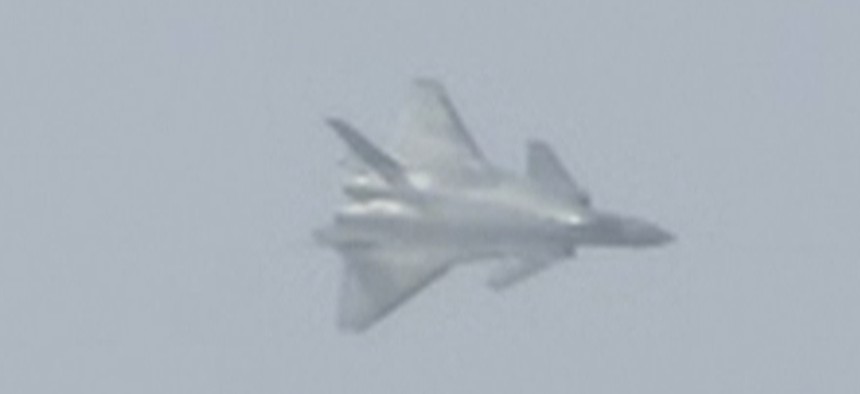
In this image made from video, the J-20 stealth fighter jet flies at the China's International Aviation and Aerospace Exhibition in Zhuhai on Nov. 1, 2016. Associated Press
As China Shows Off J-20 Stealth Fighter, A Bit of Context
It takes more than a flyby at an airshow to deploy fifth-generation fighter jets in combat.
Two Chinese J-20 fighter jets made their public debut at an airshow near Hong Kong on Tuesday, the latest sign of progress in Beijing’s quest to build a fleet of stealthy warplanes. But it takes more than a new airframe to play the 21st-century air-superiority game.
The J-20 is considered a competitor to the U.S. Air Force’s F-22 Raptor, a warplane conceived in the 1980s and built in the 1990s and early 2000s. The F-22 made its combat debut in 2014, striking Islamic State militants in Syria. Though its stealthiness gets the headlines, the Raptor’s sensors and datalinks changed how the U.S. Air Force approaches air combat.
Brig. Gen. Alexus Grynkewich, who flew F-16s before switching to the F-22, says that loose formations of 4th-generation aircraft sweeping the sky have given way to single 5th-gen aircraft seemingly alone yet connected to others far away.
“What we found was we’re often detached from each other, and we would have a bubble of air superiority around our individual aircraft,” said Grynkewich, who led a team that recently wrapped up an Air Force air-superiority road map. “In our single aircraft, we could control the airspace by working with others who were at different ranges away from us.”
“It wasn’t so much a linear battlefield anymore, but much more of a dynamic battlefield, even in the context of just that one battle in a half-hour or hour timeframe,” he said in a recent Pentagon interview. “So I think that was a little bit of a sea change in our thinking.”
Related: Air Force Officers Give New Details for F-35 in War With China
Related: Want More F-22s? Here’s What That Would Take
Related: F-35 Chief: Think Very, Very Hard Before Making Another Joint Fighter
Pentagon officials who plan for Beijing’s military buildup appear to be more concerned about China’s development of long-range, aircraft carrier-killing missiles than its stealth aircraft.
Part of the reason is numbers. Then-Defense Secretary Robert Gates predicted that the U.S. military would have far more stealth planes than China through at least 2025. Currently, the U.S. has 183 F-22 Raptors, and the Lockheed Martin assembly lines are busy turning out America’s other 5th-generation jet, the F-35 Joint Strike Fighter. By the end of the year, the U.S. and its allies will be flying more than 200 F-35s; by decade’s end, that total is slated to pass 600.
By comparison, China is believed to have a dozen J-20s: four production jets and eight prototypes used for testing. Only two developmental J-31 jets — China’s other stealthy jet, similar to the F-35 — are believed to exist.
Still, the Pentagon urged caution about these planes in its annual report to Congress on China’s military.
“These fifth-generation aircraft, which could enter service as early as 2018, will significantly improve China’s existing fleet of fourth-generation aircraft (Russian-built Su-27/Su-30 and J-11A, and indigenous J-10 and J-11B fighters) to support regional air superiority and strike operations,” said the report, released in April.
China’s military rolled out the J-20 in dramatic fashion in 2011, staging a first public test flight three days after then-Defense Secretary Robert Gates told reporters that the Chinese “may be somewhat further ahead in the development of that aircraft than our intelligence had earlier predicted.” Photos of the flight emerged after Gates touched down in Beijing for an official visit. Even China’s civilian leaders were caught off-guard, U.S. defense officials said at the time.
This was about two years after Gates halted F-22 production at 187 jets, a fraction of the 750 aircraft envisioned by Cold War planners. Air Force brass were furious, but Gates reasoned that funds would be better spent on the F-35, its bomb racks, and its own advanced sensors.




